 Or how to get lost without really trying.
Or how to get lost without really trying.
I will say upfront, that it was worth the hassles of tracking this place down for a visit. Fortunately, we hit the road early or we would have missed the start of the ‘non-refundable tour’. It did seem odd that they stressed the non-refundable part when making reservations (required) over the phone. Now I know why.
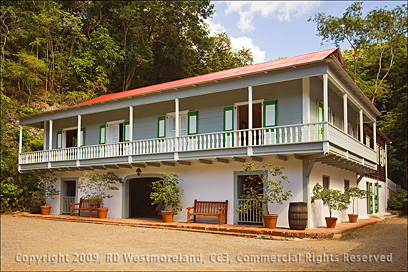 Of the 4 maps I have of PR, only one specifically mentions the Hacienda Buena Vista historical site. It was suppose to be a straight, 10 mile shot up Highway 10 from Ponce.
Of the 4 maps I have of PR, only one specifically mentions the Hacienda Buena Vista historical site. It was suppose to be a straight, 10 mile shot up Highway 10 from Ponce.
What none of the maps show is the ‘revised’ Highway 10, the new Highway 9 and Highway 123.
I got real close once, where Highway 10, turns briefly into Highway 9, before turning around and heading back up the ‘new’ Highway 10, all the way to Adjuntas. It was a beautiful, but frustrating run. I knew we had gone too far so on the way back, we stopped and asked for directions. My sidekick speaks Spanish so we were able to get good directions from a roadside vendor. At that first point where I turned around, the OLD Highway 10, intersects Highway 123.  This was the original “twisty, turny” Highway 10 up to Adjuntas. I did shoot a ‘From the Road’ video to Adjuntas and back, but my little Vado HD videocam ran out of memory before we made it all the way to the Hacienda. I plan to back-track that part of the road in the very near future. Highway 123 is marked at the turnoff (but NOT on any of my 4 maps). Its also a beautiful, but slow slog up a typical Puerto Rican highway. Once you get on Highway 123, there are a few signs pointing to Hacienda Buena Vista. Nothing before that.
This was the original “twisty, turny” Highway 10 up to Adjuntas. I did shoot a ‘From the Road’ video to Adjuntas and back, but my little Vado HD videocam ran out of memory before we made it all the way to the Hacienda. I plan to back-track that part of the road in the very near future. Highway 123 is marked at the turnoff (but NOT on any of my 4 maps). Its also a beautiful, but slow slog up a typical Puerto Rican highway. Once you get on Highway 123, there are a few signs pointing to Hacienda Buena Vista. Nothing before that.
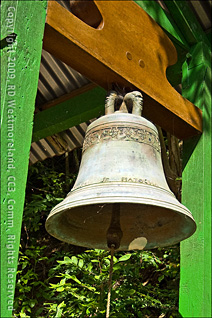 Was our experience typical? I hope not. There were 4 other couples in our English speaking tour group so they managed to find the place. All the local hotels will provide you with directions, just ask at the front desk.
Was our experience typical? I hope not. There were 4 other couples in our English speaking tour group so they managed to find the place. All the local hotels will provide you with directions, just ask at the front desk.
Note: GoogleMaps takes you directly East, up Expressway 52 from Ponce to some unknown place. Totally worthless. 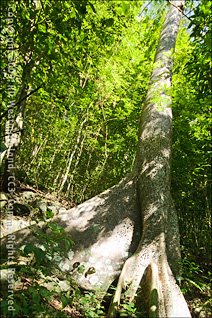 Wikipedia has a great historical piece about the Hacienda along with a brief description on how to get there. There is no dedicated Web site for Hacienda Buena Vista, though it is featured on the Conservation Trust of Puerto Rico’s Web site.
Wikipedia has a great historical piece about the Hacienda along with a brief description on how to get there. There is no dedicated Web site for Hacienda Buena Vista, though it is featured on the Conservation Trust of Puerto Rico’s Web site.
We managed to get there with 30 minutes to spare. Woohoo!
Hacienda Buena Vista (built in 1833) and 86 acres (of the original 524) were bought by the Conservation Trust of Puerto Rico in 1984. It was the Trust’s very first restoration project. An outstanding example of 19th century PR history and culture. The aquaduct system and waterworks are in full working order. Our tour guide was obviously a genuine conservationist.. her description of the local history, plant and animal life was most vivid.
The grounds and surrounding trails are very well maintained.
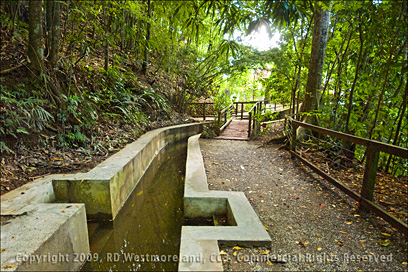 After our group assembled, we proceeded to the main building. Ground level was for warehousing coffee ready for shipping and upstairs was the weekend retreat for the original founder, Don Salvador de Vives from Venezuela. He went on to become the Mayor of Ponce in 1840 and again, in 1844. Our guide explained that before the hacienda got involved with coffee, it grew corn and milled its own corn meal. It also cultivated fruits and vegetables sold to feed some of the slave population of Ponce. The facility itself, required 57 slaves to run at its peak, later producing 10,000 pounds of Arabica coffee a year. Most of which was exported to Europe. Lucky them!
After our group assembled, we proceeded to the main building. Ground level was for warehousing coffee ready for shipping and upstairs was the weekend retreat for the original founder, Don Salvador de Vives from Venezuela. He went on to become the Mayor of Ponce in 1840 and again, in 1844. Our guide explained that before the hacienda got involved with coffee, it grew corn and milled its own corn meal. It also cultivated fruits and vegetables sold to feed some of the slave population of Ponce. The facility itself, required 57 slaves to run at its peak, later producing 10,000 pounds of Arabica coffee a year. Most of which was exported to Europe. Lucky them!
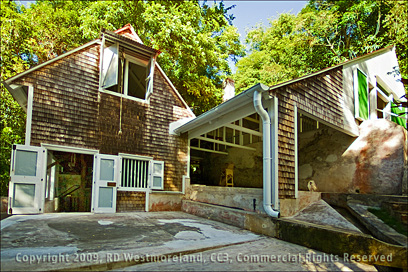 From here, we proceeded up a trail along side the concrete aqueduct. It runs the full length of the trail. Our guide explained the application and use of several local plant species, as well as the development of the water distribution system.
From here, we proceeded up a trail along side the concrete aqueduct. It runs the full length of the trail. Our guide explained the application and use of several local plant species, as well as the development of the water distribution system.
Of particular note was the Ceiba Tree of PR.. the “State” tree. Its a majestic thing, often towering over 200 feet. The root system is so robust, that the locals used to take ‘cuts’ out of it to make bowls and platters. Not anymore as its protected by PR Law. The locals refer to it as the “silk cotton tree and many know it as simply Kapok. The fluffy flower, up until recently, was used as life preserver filler.
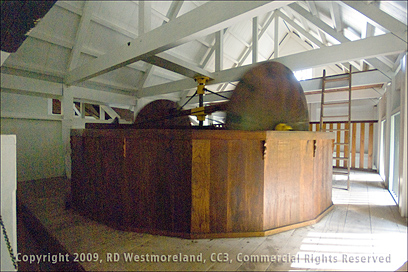
Ceibas are easy to identify.. the young trees (under 70 years old) have thorns covering the lower part of the trunk (as featured in a shot on the Tibes Post). The older ones will eventually loose their thorns.
The quarter mile trail ended abruptly with a very limited view of the ‘upper’ falls where the water is diverted to the cement aquaduct. They badly need an “overview platform” of the falls from this beautiful vantage point. It was an easy walk, up and back.
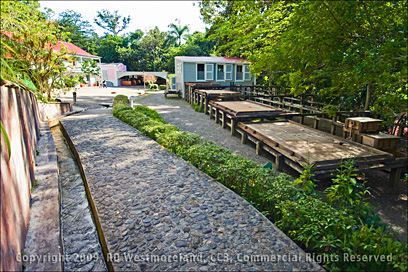
Our next stop was at the Corn drying oven, then onto the coffee de-husking mill. Both buildings are side-by-side. They ‘turned-on’ the water for us to see it in action. This drove the large red paddle wheel, that in turn, drove a pair of giant wheels used to crush the hulls from the coffee beans as can be seen in the photo. An amazing piece of machinery. We marched over to the outside coffee drying tables, where our guide explained that coffee was shipped ‘green’ and roasted once it got to its destination, helping preserve its flavor for several months. This set of heavy tables rest on roller guides so they can be pushed out into the sun during the day and back into the building at night or during inclement weather.
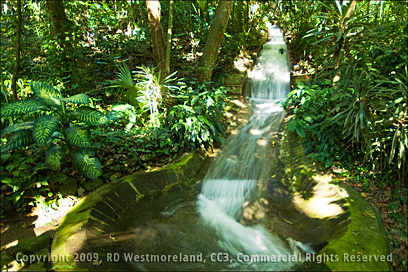 Our last trek was down to the corn mill where water was used to drive a huge milling stone and that was ‘turned-on’ for us to observe as well.
Our last trek was down to the corn mill where water was used to drive a huge milling stone and that was ‘turned-on’ for us to observe as well.
All in all, very impressive.
A little farther down the trail was a custom built cement waterfall, constructed for the pleasure of the owners.
The use of water to get things done, was almost an obsession of sorts.
I counted no less than 3 waterfalls on the property; the ‘Cement Pond’ at the bottom of the trail, the water diverter directly under the main mill for sending water back to the river when not needed and the ‘Upper’ falls at the top of the trail.
 Our final stop was at a small collection of coffee plants along side the trail. Unfortunately, the coffee bean harvest was last month so no beans were to be found on these plants. Bummer! The Conservancy plants some coffee under the existing canopy, just as its been done for the last 150 years.
Our final stop was at a small collection of coffee plants along side the trail. Unfortunately, the coffee bean harvest was last month so no beans were to be found on these plants. Bummer! The Conservancy plants some coffee under the existing canopy, just as its been done for the last 150 years.
I want to check out some of the other Conservation Trust of Puerto Rico projects, down the road. I will add a link to the Conservancy Web site, in the right hand column.
A very worthy cause
Was it worth the $7 for adults (65 for Senior discount) to get in? You betcha! Its a great way to spend a couple hours. BUT finding the place was a real pain in the…
For that reason, I can only give it 4 skulls.. ARRG!
![]()
Jose w vazquez says
I’m a Boricua living in Ohio..Love Puerto Rico..Thanks for the wonderful information
JOE says
I first visited Hacienda Buena Vista 7 years ago as an architecture student. We were exploring the site as part of a design 3rd year design studio. We were all free to choose what to built, most of us proposed a viewing platform. (Ed-Thanx, Arrg!)
ONancy says
You’re getting quite a collection of info here. This is where I’ll make my plans before my next trip! Thanks for doing all the “in depth” reports, it really helps decide where to go!
LaLa says
Beautiful pictures and thanks for sharing them. I’m definitely putting this one on our list for when we return. Such interesting history!
Even though El Yunque is the designated rain forest, I swear, the entire island is a giant rain forest. Looking at the lush greenery here takes my breath away.